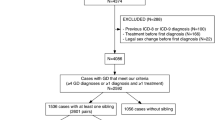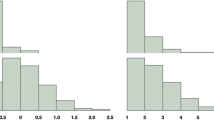Abstract
Familial studies and reports of co-occurrence of gender identity disorder (GID) within a family may help to clarify the question of whether transsexualism is a familial phenomenon. In a sample of 995 consecutive transsexual probands (677 male-to-female [MF] and 318 female-to-male [FM]), we report 12 pairs of transsexual non-twin siblings (nine pairs of MF siblings, two pairs of MF-FM siblings, and one pair of FM siblings). The present study doubles the number of case reports of co-occurrence of transsexualism in non-twin siblings available in the literature. According to our data, the probability that a sibling of a transsexual will also be transsexual was 4.48 times higher for siblings of MF than for siblings of FM transsexual probands, and 3.88 times higher for the brothers than for the sisters of transsexual probands. Moreover, the prevalence of transsexualism in siblings of transsexuals (1/211 siblings) was much higher than the range expected according to the prevalence data of transsexualism in Spain. The study suggests that siblings of transsexuals may have a higher risk of being transsexual than the general population, and that the risk is higher for brothers than sisters of transsexuals, and for siblings of MF than FM transsexuals. Nevertheless, the risk is low.
Similar content being viewed by others
Notes
Data of other familial case reports from that population (two pairs of DZ twin siblings, eight pairs of first and second cousins, and three MF probands who have an uncle concordant for MF transsexualism) are available from the corresponding author upon request.
Data on siblings of FM probands were not compared, since only one familial case has been described.
Statistical comparison of two proportions was not performed because of the low prevalence data in the general population.
References
American Psychiatric Association. (1994). Diagnostic and statistical manual of mental disorders (4th ed.). Washington, DC: Author.
Anchersen, P. (1956). Problems of transvestism. Acta Psychiatrica Neurologica Scandinavica, 106(Suppl), 249–256.
Bailey, J. M., Dunne, M. P., & Martin, N. G. (2000). Genetic and environmental influences on sexual orientation and its correlates in an Australian twin sample. Journal of Personality and Social Psychology, 78, 524–536.
Ball, J. R. (1981). Thirty years experience with transsexualism. Australia and New Zealand Journal of Psychiatry, 15, 39–43.
Bentz, E. K., Hefler, L. A., Kaufmann, U., Huber, J. C., Kolbus, A., & Tempfer, C. B. (2008). A polymorphism of the CYP17 gene related to sex steroid metabolism is associated with female-to-male transsexualism but not male-to-female transsexualism. Fertility and Sterility, 90, 56–59.
Bergero Miguel, T., Cano Oncala, G., Esteva de Antonio, I., Giraldo, F., Gornemann Schaffer, I., & Alvarez Ortega, P. (2001). Evaluación diagnóstica y seguimiento psicológico en la Unidad de Trastornos de Identidad de Género en Andalucía, Málaga [Psychological evaluation and follow-up by the Andalusian Gender Identity Disorder Unit in Malaga, Spain]. Cirugía Plástica Ibero-latinoamericana, 27, 263–272.
Blanchard, R., & Sheridan, P. (1992). Sibship size, sibling sex ratio, birth order, and parental age in homosexual and nonhomosexual gender dysphorics. Journal of Nervous and Mental Disease, 180, 40–47.
Buhrich, N., Barr, R., & Lam-Po-Tang, P. R. L. C. (1978). Two transsexuals with 47 XYY karyotype. British Journal of Psychiatry, 133, 77–81.
Cohen-Kettenis, P. T., & Gooren, L. J. G. (1999). Transsexualism: A review of etiology, diagnosis and treatment. Journal of Psychosomatic Research, 46, 315–333.
Coolidge, F. L., Thede, L. L., & Young, S. E. (2002). The heritability of gender identity disorder in a child and adolescent twin sample. Behavior Genetics, 32, 251–257.
Esteva, I., Giraldo, F., Bergero, T., Cano, G., Crespillo, C., Ruíz, S., et al. (2001). Evaluación endocrinológica y tratamiento hormonal de la transexualidad en la Unidad de Trastornos de Identidad de Género en Andalucía (Málaga) [Endocrinological evaluation and hormone treatment of transsexuality by the Andalusian Gender Identity Disorder Unit in Malaga (Spain)]. Cirugía Plástica Ibero-latinoamericana, 27, 273–280.
Esteva, I., Gonzalo, M., Yahyaoui, R., Domínguez, M., Berguero, T., & Giraldo, F. (2006). Epidemiología de la transexualidad en Andalucía: especial atención al grupo de adolescentes [Epidemiology of transsexualism in Andalusia: Special attention to the adolescent group]. Cuadernos de Medicina Psicosomática, 78, 65–70.
Garden, G. M., & Rothery, D. J. (1992). A female monozygotic twin pair discordant for transsexualism. Some theoretical implications. British Journal of Psychiatry, 161, 852–854.
Gómez-Gil, E., & Esteva de Antonio, I. (2006). Ser transexual [Being transsexual]. Barcelona: Editorial Glosa.
Gómez-Gil, E., Trilla, A., Salamero, M., Godás, T., & Valdés, M. (2009). Sociodemographic, clinical, and psychiatric characteristics of transsexuals from Spain. Archives of Sexual Behavior, 38, 378–392.
Gómez-Gil, E., Trilla-García, A., Godás-Sieso, T., Halperin-Rabinovich, I., Puig Domingo, M., Vidal Hagemeijer, A., et al. (2006). Estimación de la prevalencia, incidencia y razón de sexos del transexualismo en Cataluña según la demanda asistencial [Estimation of prevalence, incidence and sex ratio of transsexualism in Catalonia according to health care demand]. Actas Españolas de Psiquiatría, 34, 295–302.
Gooren, L. (2006). The biology of human psychosexual differentiation. Hormones and Behavior, 50, 589–601.
Gooren, L., Frantz, R. R., Eriksson, A. W., & Rao, B. R. (1989, August). Transsexualism in twins. Paper presented at the meeting of the International Congress of Twin Studies, Rome.
Green, R. (2000). Family cooccurrence of “gender dysphoria”: Ten sibling of parent-child pairs. Archives of Sexual Behavior, 29, 499–507.
Green, R., & Stoller, R. J. (1971). Two pairs of monozygotic (identical) twins discordant for gender identity. Archives of Sexual Behavior, 1, 321–328.
Grumbach, M. M., Hughes, I. A., & Conte, F. A. (2003). Disorders of sex differentiation. In P. R. Larsen, H. M. Kronenberg, S. Melmed, & K. S. Polonsky (Eds.), Williams textbook of endocrinology (10th ed., pp. 842–1002). Philadelphia: Saunders Company.
Haberman, M., Hollingsworth, F., Falek, A., & Michael, R. P. (1975). Gender identity confusion, schizophrenia and 47 XYY karyotype: A case report. Psychoneuroendocrinology, 1, 207–209.
Hare, L., Bernard, P., Sánchez, F. J., Baird, P. N., Vilain, E., Kennedy, T., et al. (2009). Androgen receptor repeat length polymorphism associated with male-to-female transsexualism. Biological Psychiatry, 65, 93–96.
Hengstschläger, M., van Trotsenburg, M., Repa, C., Marton, E., Huber, J. C., & Bernaschek, H. (2003). Sex chromosome aberrations and transsexualism. Fertility and Sterility, 79, 639–640.
Henningsson, S., Westberg, L., Nilsson, S., Lundström, B., Ekselius, L., Bodlund, O., et al. (2005). Sex steroid-related genes and male-to-female transsexualism. Psychoneuroendocrinology, 30, 657–664.
Hepp, U., Milos, G., & Braun-Sharm, H. (2004). Gender identity disorder and anorexia nervosa in male monozygotic twins. International Journal of Eating Disorders, 35, 239–243.
Hore, B. D., Nicolle, F. V., & Calnan, J. S. (1973). Male transsexualism: Two cases in a single family. Archives of Sexual Behavior, 2, 317–321.
Hyde, C., & Kenna, J. C. (1977). A male MZ twin pair, concordant for transsexualism, discordant for schizophrenia. Acta Psychiatrica Scandinavica, 56, 265–275.
Joyce, P., & Ding, L. (1985). Transsexual sisters. Australian and New Zealand Journal of Psychiatry, 19, 1988–1989.
Knafo, A., Iervolino, A. C., & Plomin, R. (2005). Masculine girls and feminine boys: Genetic and environmental contributions to atypical gender development in early childhood. Journal of Personality and Social Psychology, 88, 400–412.
Kruijver, F. P. M., Zhou, J. N., Pool, C. W., Hofman, M. A., Gooren, L. J. G., & Swaab, D. F. (2000). Male-to-female transsexuals have female neuron numbers in a limbic nucleus. Journal of Clinical Endocrinology and Metabolism, 85, 2034–2041.
Lawrence, A. A. (2008). Societal individualism predicts prevalence of nonhomosexual orientation in male-to-female transsexualism. Archives of Sexual Behavior. doi:10.1007/s10508-008-9420-3.
McKee, E. A., Roback, H. B., & Hollender, M. H. (1976). Transsexualism in two male triplets. American Journal of Psychiatry, 133, 334–340.
Meyer, W., Bockting, W., Cohen-Kettenis, P., Coleman, E., DiCeglie, D., Devor, H., et al. (2001). The Harry Benjamin Gender Dysphoria Association′s Standards of Care for Gender Identity Disorders, sixth version. Journal of Psychology and Human Sexuality, 13, 1–30.
Michel, A., Mormont, C., & Legros, J. J. (2001). A psycho-endocrinological overview of transsexualism. European Journal of Endocrinology, 145, 365–376.
Sabalis, R. F., Frances, A., Appenzeller, S. N., & Moseley, W. B. (1974). The three sisters: Transsexual male siblings. American Journal of Psychiatry, 131, 907–909.
Sadeghi, M., & Fakhrai, A. (2000). Transsexualism in female monozygotic twins: A case report. Australian and New Zealand Journal of Psychiatry, 34, 862–864.
Segal, N. (2006). Two monozygotic twin pairs discordant for female-to-male transsexualism. Archives of Sexual Behavior, 35, 347–358.
Segovia, S., Guillamon, A., del Cerro, M. C. R., Ortega, E., Perez-Laso, C., Rodríguez-Zafra, M., et al. (1999). The development of brain sex differences: A multisignaling process. Behavioral Brain Research, 105, 69–80.
Snaith, R. P., Penhale, S., & Horsfield, P. (1991). Male-to-female transsexual with XYY karyotype. Lancet, 337, 557–558.
Sosa, M., Jódar, E., Arbelo, E., Domínguez, C., Saavedra, P., Torres, A., et al. (2004). Serum lipids and estrogen receptor gene polymorphisms in male-to-female transsexuals: Effects of estrogen treatment. European Journal of Internal Medicine, 15, 231–237.
Stoller, R. J., & Baker, H. J. (1973). Two male transsexuals in one family. Archives of Sexual Behavior, 2, 323–328.
Swaab, D. F. (2004). Sexual differentiation of the human brain: Relevance for gender identity, transsexualism and sexual orientation. Gynecology and Endocrinology, 19, 301–312.
Taneja, N., Ammini, A. C., Mohapatra, I., Saxena, S., & Kucheria, K. (1992). A transsexual male with 47,XYY karyotype. British Journal of Psychiatry, 161, 698–699.
Tsur, H., Borenstein, A., & Seidman, D. S. (1991). Transsexualism. Lancet, 388, 945–946.
Turan, M. T., Esel, E., Dündar, M., Candemir, Z., Bastürk, M., Sofuoglu, S., et al. (2000). Female-to-male transsexual with 47,XXX karyotype. Biological Psychiatry, 48, 1116–1117.
Wagner, B. (1974). Ein transsexueller mit XYY syndrom. Nervenarzt, 45, 548–551.
World Health Organization. (1993). International classification of diseases: Diagnostic criteria for research (10th ed.). Geneva: Author.
Zhou, J. N., Hofman, M. A., Gooren, L. J. G., & Swaab, D. F. (1995). A sex difference in the human brain and its relation to transsexuality. Nature, 378, 68–70.
Zucker, K. J., & Bradley, S. J. (1995). Gender identity disorder and psychosexual problems in children and adolescents. New York: Guilford Press.
Acknowledgements
We are thankful to the patients and their families for their cooperation. The work of AG, EG, EP and SS is supported by grants SEJ2007-65686/PSIC, SAF2004-22551-E and PI-0254/2007 JA.
Author information
Authors and Affiliations
Corresponding author
Rights and permissions
About this article
Cite this article
Gómez-Gil, E., Esteva, I., Almaraz, M.C. et al. Familiality of Gender Identity Disorder in Non-Twin Siblings. Arch Sex Behav 39, 546–552 (2010). https://doi.org/10.1007/s10508-009-9524-4
Received:
Revised:
Accepted:
Published:
Issue Date:
DOI: https://doi.org/10.1007/s10508-009-9524-4




